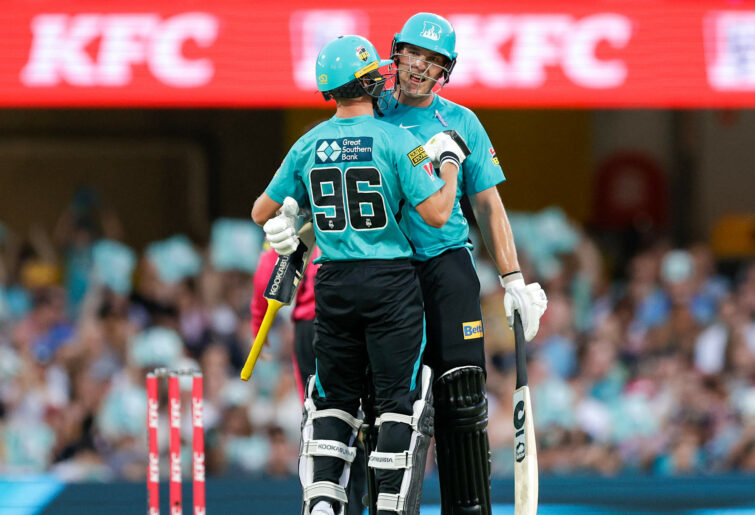Head and shoulders above: Why Trav is the key to Australia's T20 World Cup success
In just under three weeks, the 2024 Men’s T20 World Cup will commence in Texas as the United States face off against Canada in…
The Big Bash League came under fire during the COVID-impacted 2020-21 and 2021-22 seasons, as the increased presence of non-state-contracted replacement players plucked from club cricket became a recurring point of criticism with fans (and a particular broadcaster).
Suddenly, the memories of players like Ricky Ponting, Shane Warne, AB de Villiers and Lasith Malinga in the BBL seemed distant, and our screens were filled with names that only the keenest of cricket observers could distinguish the local players from the imports.
Josh Brown’s instantly memorable 62 off just 23 balls at the Gabba on New Year’s Day was a fresh reminder of the quality lurking amongst the cricketers we’ve never heard of in local Premier Cricket.
The BBL has plenty of challenges – length of season and the effect this has on the quality of available international players chief among them – but the cream of the crop at the next level down are more than capable of making an impact in the BBL, as Brown showed us on Sunday night.
Brown’s innings, seemingly out of nowhere in just his second BBL start, should be a call to action for Cricket Australia to get more serious about its “next level” of talent, in T20 cricket in particular.

(Photo by Russell Freeman/Getty Images)
India’s leading domestic T20 competition, the Syed Mushtaq Ali Trophy, actually predates the Indian Premier League by a full season and features an incredible 38 teams of professional and semi-professional players.
Without the presence of global superstars like the IPL, the international attention is limited, but the quality of cricket is high, and the competition has become a nursery for developing Indian talent. Every year, new heroes emerge in the IPL; they are already household names to many Indian fans based on past exploits in the Syed Mushtaq Ali Trophy.
Australia doesn’t have the population or the financial backing of cricket in India, obviously, but the desire to close the gap between club cricket and the BBL should be on the radar. A league or tournament restricted to Australian players only, played in addition to the Big Bash, could become a driving force behind increasing the quality of the local talent in the BBL, and eventually the national side.
With a T20 World Cup scheduled every two years through 2030, and the obvious trend of cricketing investment towards the shortest format of the game, it’s a logical next step to support the golden goose that is the BBL.
Most cricket fans are aware of the Top End T20, a 10-day tournament held in Darwin each winter, that attracts a range of Australia’s future stars, many of whom already have some state cricket and BBL experience. An expansion on this format creates a unique opportunity for Australia to continue developing the next crop of players to a high standard, while keeping the focus in the school holiday window on the BBL.
While a 38-team, multi-division competition to mimic that of India’s is well out of reach, a World Cup-style T20 tournament for the existing state programs could give Australia a realistic chance at replicating the multi-tiered professional T20 structure.
For Cricket Australia, creating additional opportunities for players to experience the pressure of knockout games in a higher-stakes, televised environment also bodes well for our future stars when they find themselves in the hot seat in global tournaments in the years ahead. The best way to prepare for the pressure-cooker of a knockout game on the biggest stage is to have played a few on a slightly smaller stage on the way through.
State and Australian-capped players wanting additional time in the middle, or returning from injuries, could add star power to such a competition. Broadcasters get more (quality) cricket for our screens, and a high-quality product can still be produced for TV without the exorbitant costs of a Test match or T20 fixture as the BBL showed us when nearby storms knocked out the main cameras at a game in Launceston three seasons ago.
With only limited cameras at their disposal for much of the game, viewers were still treated to a high-quality production. Cutting down on the number of cameras, playing more games across fewer venues to reduce set-up and take-down costs and doing away with luxury extras like ball tracking would keep production costs at a more reasonable level, without sacrificing too much of the viewer experience.
Sure – the usual concerns for any new league or competition, most of which are financial, apply here as much as ever. But if the BBL is to continue to drive revenues and keep Cricket Australia afloat in the years to come, investing in it’s future (and the future success of the national team in the shortest format) seems like the perfect place to start.